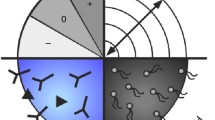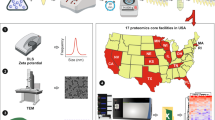Abstract
Nanoparticles used in biological settings are exposed to proteins that adsorb on the surface forming a protein corona. These adsorbed proteins dictate the subsequent cellular response. A major challenge has been predicting what proteins will adsorb on a given nanoparticle surface. Instead, each new nanoparticle and nanoparticle modification must be tested experimentally to determine what proteins adsorb on the surface. We propose that any future predictive ability will depend on large datasets of protein-nanoparticle interactions. As a first step towards this goal, we have developed an automated workflow using a liquid handling robot to form and isolate protein coronas. As this workflow depends on magnetic separation steps, we test the ability to embed magnetic nanoparticles within a protein nanoparticle. These experiments demonstrate that magnetic separation could be used for any type of nanoparticle in which a magnetic core can be embedded. Higher-throughput corona characterization will also require lower-cost approaches to proteomics. We report a comparison of fast, low-cost, and standard, slower, higher-cost liquid chromatography coupled with mass spectrometry to identify the protein corona. These methods will provide a step forward in the acquisition of the large datasets necessary to predict nanoparticle-protein interactions.





Similar content being viewed by others
References
Lynch I, Cedervall T, Lundqvist M, Cabaleiro-Lago C, Linse S, Dawson KA. The nanoparticle-protein complex as a biological entity; a complex fluids and surface science challenge for the 21st century. Adv Colloid Interface Sci. 2007;134-135:167–74.
Walczyk D, Bombelli FB, Monopoli MP, Lynch I, Dawson KA. What the cell “sees” in bionanoscience. J Am Chem Soc. 2010;132:5761–8.
Park S, Hamad-Schifferli K. Nanoscale interfaces to biology. Curr Opin Chem Biol. 2010;14:616–22.
Walkey CD, Chan WCW. Understanding and controlling the interaction of nanomaterials with proteins in a physiological environment. Chem Soc Rev. 2012;41:2780–99.
Del Pino P, Pelaz B, Zhang Q, Maffre P, Nienhaus GU, Parak WJ. Protein corona formation around nanoparticles - from the past to the future. Mater Horiz. 2014;1:301–13.
Fleischer CC, Payne CK. Nanoparticle-cell interactions: molecular structure of the protein corona and cellular outcomes. Acc Chem Res. 2014;47:2651–9.
Ke PC, Lin S, Parak WJ, Davis TP, Caruso F. A decade of the protein corona. ACS Nano. 2017;11:11773–6.
Mahmoudi M, Bertrand N, Zope H, Farokhzad OC. Emerging understanding of the protein corona at the nano-bio interfaces. Nano Today. 2016;11:817–32.
Yang ST, Liu Y, Wang YW, Cao AN. Biosafety and bioapplication of nanomaterials by designing protein-nanoparticle interactions. Small. 2013;9:1635–53.
Payne CK. A protein corona primer for physical chemists. J Chem Phys. 2019;151:130901.
Aggarwal P, Hall JB, McLeland CB, Dobrovolskaia MA, McNeil SE. Nanoparticle interaction with plasma proteins as it relates to particle biodistribution, biocompatibility and therapeutic efficacy. Adv Drug Deliv Rev. 2009;61:428–37.
Owens DE III, Peppas NA. Opsonization, biodistribution, and pharmacokinetics of polymeric nanoparticles. Int J Pharm. 2006;307:93–102.
Khlebtsov N, Dykman L. Biodistribution and toxicity of engineered gold nanoparticles: a review of in vitro and in vivo studies. Chem Soc Rev. 2011;40:1647–71.
Duan XP, Li YP. Physicochemical characteristics of nanoparticles affect circulation, biodistribution, cellular internalization, and trafficking. Small. 2013;9:1521–32.
Chinen AB, Guan CM, Ko CH, Mirkin CA. The impact of protein corona formation on the macrophage cellular uptake and biodistribution of spherical nucleic acids. Small. 2017;13:#1603847.
Wilhelm S, Tavares AJ, Dai Q, Ohta S, Audet J, Dvorak HF, et al. Analysis of nanoparticle delivery to tumours. Nat Rev Mater. 2016;1:16014.
Hellstrand E, Lynch I, Andersson A, Drakenberg T, Dahlbäck B, Dawson KA, et al. Complete high-density lipoproteins in nanoparticle corona. FEBS J. 2009;276:3372–81.
Olenick LL, Troiano JM, Vartanian A, Melby ES, Mensch AC, Zhang L, et al. Lipid corona formation from nanoparticle interactions with bilayers. Chem. 2018;4:2709–23.
Pink M, Verma N, Kersch C, Schmitz-Spanke S. Identification and characterization of small organic compounds within the corona formed around engineered nanoparticles. Environ Sci Nano. 2018;5:1420–7.
Khot LR, Sankaran S, Maja JM, Ehsani R, Schuster EW. Applications of nanomaterials in agricultural production and crop protection: a review. Crop Prot. 2012;35:64–70.
Liu R, Lal R. Potentials of engineered nanoparticles as fertilizers for increasing agronomic productions. Sci Total Environ. 2015;514:131–9.
Kah M, Hofmann T. Nanopesticide research: current trends and future priorities. Environ Int. 2014;63:224–35.
Giraldo JP, Wu HH, Newkirk GM, Kruss S. Nanobiotechnology approaches for engineering smart plant sensors. Nat Nanotechnol. 2019;14:541–53.
Hochella MF, Mogk DW, Ranville J, Allen IC, Luther GW, Marr LC, et al. Natural, incidental, and engineered nanomaterials and their impacts on the Earth system. Science. 2019;363:eaau8299.
Mauter MS, Zucker I, Perreault F, Werber JR, Kim JH, Elimelech M. The role of nanotechnology in tackling global water challenges. Nat Sustain. 2018;1:166–75.
Kaegi R, Voegelin A, Sinnet B, Zuleeg S, Siegrist H, Burkhardt M. Transformation of AgCl nanoparticles in a sewer system — a field study. Sci Total Environ. 2015;535:20–7.
Lopez H, Lobaskin V. Coarse-grained model of adsorption of blood plasma proteins onto nanoparticles. J Chem Phys. 2015;143:#243138.
Voicescu M, Ionescu S, Angelescu DG. Spectroscopic and coarse-grained simulation studies of the BSA and HSA protein adsorption on silver nanoparticles. J Nanopart Res. 2012;14:1174.
Ding F, Radic S, Chen R, Chen P, Geitner NK, Brown JM, et al. Direct observation of a single nanoparticle–ubiquitin corona formation. Nanoscale. 2013;5:9162–9.
Wei S, Ahlstrom LS, Brooks CL. Exploring protein–nanoparticle interactions with coarse-grained protein folding models. Small. 2017;13:#1603748.
H-m D, Ma Y-q. Computer simulation of the role of protein corona in cellular delivery of nanoparticles. Biomaterials. 2014;35:8703–10.
Li R, Chen R, Chen P, Wen Y, Ke PC, Cho SS. Computational and experimental characterizations of silver nanoparticle–apolipoprotein biocorona. J Phys Chem B. 2013;117:13451–6.
Li R, Stevens CA, Cho SS. Molecular dynamics simulations of biocorona formation. In: Suzuki J, Nakano T, Moore MJ, editors. Modeling, methodologies and tools for molecular and nano-scale communications: modeling, methodologies and tools: Springer International; 2017. p. 241–56.
Manning MD, Kwansa AL, Oweida T, Peerless JS, Singh A, Yingling YG. Progress in ligand design for monolayer-protected nanoparticles for nanobio interfaces. Biointerphases. 2018;13:06D502.
Deyev S, Proshkina G, Ryabova A, Tavanti F, Menziani MC, Eidelshtein G, et al. Synthesis, characterization, and selective delivery of DARPin–gold nanoparticle conjugates to cancer cells. Bioconjug Chem. 2017;28:2569–74.
Tavanti F, Pedone A, Menziani MC. Competitive binding of proteins to gold nanoparticles disclosed by molecular dynamics simulations. J Phys Chem C. 2015;119:22172–80.
Cui Q, Hernandez R, Mason SE, Frauenheim T, Pedersen JA, Geiger F. Sustainable nanotechnology: opportunities and challenges for theoretical/computational studies. J Phys Chem B. 2016;120:7297–306.
Liang D, Hong J, Fang D, Bennett JW, Mason SE, Hamers RJ, et al. Analysis of the conformational properties of amine ligands at the gold/water interface with QM, MM and QM/MM simulations. Phys Chem Chem Phys. 2018;20:3349–62.
Van Lehn RC, Alexander-Katz A. Structure of mixed-monolayer-protected nanoparticles in aqueous salt solution from atomistic molecular dynamics simulations. J Phys Chem C. 2013;117:20104–15.
Brancolini G, Maschio MC, Cantarutti C, Corazza A, Fogolari F, Bellotti V, et al. Citrate stabilized gold nanoparticles interfere with amyloid fibril formation: D76N and ΔN6 β2-microglobulin variants. Nanoscale. 2018;10:4793–806.
Fleischer CC, Payne CK. Nanoparticle surface charge mediates the cellular receptors used by protein-nanoparticle complexes. J Phys Chem B. 2012;116:8901–7.
Fleischer CC, Kumar U, Payne CK. Cellular binding of anionic nanoparticles is inhibited by serum proteins independent of nanoparticle composition. Biomater Sci. 2013;1:975–82.
Fleischer CC, Payne CK. Secondary structure of corona proteins determines the cell surface receptors used by nanoparticles. J Phys Chem B. 2014;118:14017–26.
Hill A, Payne CK. Impact of serum proteins on MRI contrast agents: cellular binding and T2 relaxation. RSC Adv. 2014;4:31735–44.
Walkey CD, Olsen JB, Song F, Liu R, Guo H, Olsen DWH, et al. Protein corona fingerprinting predicts the cellular interaction of gold and silver nanoparticles. ACS Nano. 2014;8:2439–55.
Findlay MR, Freitas DN, Mobed-Miremadi M, Wheeler KE. Machine learning provides predictive analysis into silver nanoparticle protein corona formation from physicochemical properties. Environ Sci Nano. 2018;5:64–71.
Lazarovits J, Sindhwani S, Tavares AJ, Zhang Y, Song F, Audet J, et al. Supervised learning and mass spectrometry predicts the in vivo fate of nanomaterials. ACS Nano. 2019;13:8023–34.
Chan EM, Xu C, Mao AW, Han G, Owen JS, Cohen BE, et al. Reproducible, high-throughput synthesis of colloidal nanocrystals for optimization in multidimensional parameter space. Nano Lett. 2010;10:1874–85.
Pendleton IM, Cattabriga G, Li Z, Najeeb MA, Friedler SA, Norquist AJ, et al. Experiment specification, capture and laboratory automation technology (ESCALATE): a software pipeline for automated chemical experimentation and data management. MRS Communications. 2019;9:846–59.
Runa S, Khanal D, Kemp ML, Payne CK. TiO2 nanoparticles alter the expression of peroxiredoxin antioxidant genes. J Phys Chem C. 2016;120:20736–42.
Jayaram DT, Runa S, Kemp ML, Payne CK. Nanoparticle-induced oxidation of corona proteins initiates an oxidative stress response in cells. Nanoscale. 2017;9:7595–601.
Jayaram DT, Pustulka SM, Mannino RG, Lam WA. Protein corona in response to flow: effect on protein concentration and structure. Biophys J. 2018;115:209–16.
Jayaram DT, Kumar A, Kippner LE, Ho P-Y, Kemp ML, Fan Y, et al. TiO2 nanoparticles generate superoxide and alter gene expression in human lung cells. RSC Adv. 2019;9:25039–47.
Etorki AM, Gao M, Sadeghi R, Maldonado-mejia LF, Kokini JL. Effects of desolvating agent types, ratios, and temperature on size and nanostructure of nanoparticles from α-lactalbumin and ovalbumin. J Food Sci. 2016;81:E2511–20.
Chang TZ, Stadmiller SS, Staskevicius E, Champion JA. Effects of ovalbumin protein nanoparticle vaccine size and coating on dendritic cell processing. Biomat Sci. 2017;5:223–33.
Schneider CA, Rasband WS, Eliceiri KW. NIH image to ImageJ: 25 years of image analysis. Nat Methods. 2012;9:671.
Rimkus G, Bremer-Streck S, Grüttner C, Kaiser WA, Hilger I. Can we accurately quantify nanoparticle associated proteins when constructing high-affinity MRI molecular imaging probes? Contrast Media Mol Imaging. 2011;6:119–25.
Gruttner C, Muller K, Teller J. A rapid assay to measure the shielding of iron oxide cores by the particle shell. IEEE Trans Magn. 2012;49:177–81.
Muller J, Bauer KN, Prozeller D, Simon J, Mailander V, Wurm FM, et al. Coating nanoparticles with tunable surfactants facilitates control over the protein corona. Biomaterials. 2017;115:1–8.
Chang TZ, Diambou I, Rok J, Baozhong K, Champion JA. Host- and pathogen-derived adjuvant coatings on protein nanoparticle vaccines. Bioeng Transl Med. 2017;2:120–30.
Deng L, Mohan T, Chang TZ, Gonzalez GX, Wang Y, Kwon Y, et al. Double-layerd protein nanoparticles induce broad protection against divergent influenza A viruses. Nat Commun. 2018;9:1–12.
Sakulkhu U, Maurizi L, Mahmoudi M, Motazacker M, Vries M, Gramoun A, et al. Ex situ evaluation of the composition of protein corona of intravenously injected superparamagnetic nanoparticles in rats. Nanoscale. 2014;6:11439–50.
Chen F, Wang G, Griffin JI, Brenneman B, Banda NK, Holers VM, et al. Complement proteins bind to nanoparticle protein corona and undergo dynamic exchange in vivo. Nat Nanotechnol. 2017;12:387.
Vizcaíno JA, Deutsch EW, Wang R, Csordas A, Reisinger F, Rios D, et al. ProteomeXchange provides globally coordinated proteomics data submission and dissemination. Nat Biotechnol. 2014;32:223–6.
Acknowledgments
The authors thank Dhanya T. Jayaram and Gustavo Sosa Macias for their assistance with the experiments. The protein NP TEM work was performed at the Georgia Tech Institute for Electronics and Nanotechnology, a member of the National Nanotechnology Coordinated Infrastructure, which is supported by the National Science Foundation (ECCS-1542174). We thank the Duke University School of Medicine for the use of the Proteomics and Metabolomics Shared Resource, which provided proteomics service, with special thanks to Erik Soderblom for the discussion and technical advice. Thomas Pho was supported by a fellowship from the American Chemical Society Bridge Program.
Funding
This study received funding from the NSF (CBET-1901579) and NIH (NIAID 2R01AI101047-06A1).
Author information
Authors and Affiliations
Corresponding authors
Ethics declarations
Conflict of interest
The authors declare that they have no conflicts of interest.
Additional information
Publisher’s note
Springer Nature remains neutral with regard to jurisdictional claims in published maps and institutional affiliations.
Published in the topical collection featuring Female Role Models in Analytical Chemistry.
Electronic supplementary material
ESM 1
(PDF 406 kb).
Rights and permissions
About this article
Cite this article
Poulsen, K.M., Pho, T., Champion, J.A. et al. Automation and low-cost proteomics for characterization of the protein corona: experimental methods for big data. Anal Bioanal Chem 412, 6543–6551 (2020). https://doi.org/10.1007/s00216-020-02726-1
Received:
Revised:
Accepted:
Published:
Issue Date:
DOI: https://doi.org/10.1007/s00216-020-02726-1




